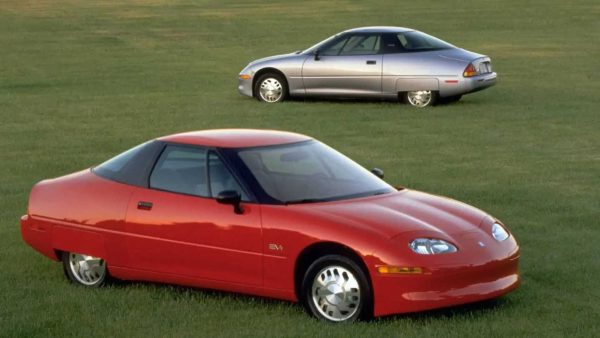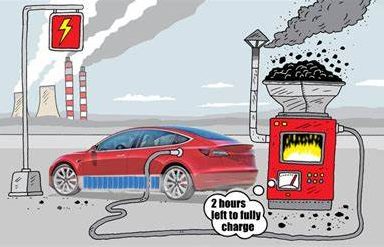Overview
Some of you might remember what happened in in 1996: when the General Motors EV-1 came out to the general public. I’m sure the teachers here at THS would remember, it was the first ever mass produced electric car, but why don’t we ever see any on the road today? Well for starters, at this point they are 30+ years old. Secondly, GM wanted all the EV-1’s back, but why? Well the answer was simple, because we as Americans realized that we weren’t ready to embrace the future of all electric vehicles, due to the crippling problems that came with them. The EV-1 didn’t have many problems, but due to the amount of money they were spending on making these cars (and how much they made back from them), they decided to totally scrap the program, and buy back all of the EV-1 cars from their customers. These cars met their eventual fate at the scrapyard.

After that, we didn’t see a mass-produced electric car for many years until in 2007, when a well-known entrepreneur we know today as Elon Musk created Tesla, and released their first battery electric vehicle in 2008 called the Tesla Roadster. It was based on a Lotus Elise Chassis, which technically wasn’t his design, as the roadster was just a rebodied Lotus Elise (which is quite obvious when putting the 2 cars next to each other) and you can easily tell they are related. Nobody knows how many were made, but from 2008-2012 their next big project developed completely on their own until the Roadster was killed off by Tesla to make way for the new wave.

History

Meanwhile, at Nissan, they were hopping on the electric car bandwagon in 2010, with their first ever electric car called the Leaf. It was released in Europe and Canada in 2011, before making its ways into the states in 2013. Another competitor in the game was the Mitsubishi I-MHEV, which quite frankly is probably the worst electric car ever made but that’s another story for another day. The Nissan Leaf saw instant success in the states, making it the #1 best selling electric vehicle in the US. To this day, the Leaf is the cheapest electric car for the middle class.
Back at Tesla, in 2013 they unveiled the Model-S, their first ever electric car developed in house by their designers without the help of anyone else. The Model-S saw massive success as many people were very impressed that the fundamentals of the automobile have reached this far in the advancement of technology, while many other brands started coming out with their own electric vehicles. Fiat came out with a battery powered version of their iconic Fiat 500 compact city car; BMW comes out with their “I” electric lineup featuring 2 cars: the I3 compact city car and the I8 Hybrid Supercar; Smart one-ups Fiat with their Electrified Fortwo an electric version of their beloved micro-car; Chevy makes an electric Spark car, and they also make a compact sedan called the Volt. It continued when VW cames out with an Electric Golf, and all these were seen as marketing successes for the EV world. Unfortunately, the same can’t be said for some such as Cadillac coming out with a overpriced Chevy Volt called the ELR, with a depressing 42-mile range and a $82,000 price tag (when new); Kia made an electric Soul which was as boring as the gas powered one; Mercedes-Benz released an Electric B-Klasse which failed from the start; Toyota made a EV version of their Rav4, which only sold 2,600 units as it was a total failure, but quite a rarity.

With all these new electric vehicles that came out in 2014, they were dominating the market with sales, and many consumers thought this was the answer to saving the environment. However, it only made it worse as the years progressed. In 2017, many electric cars were on the market with Tesla at #1, but this didn’t stop the auto maker from developing a new vehicle. Tesla released the Model 3 as a compact hatchback/sedan, with a starting price of $35,000 to make an electric car affordable for all. As the years progressed, they easily sold thousands, which made its way into the hundred thousands, then into the millions. With that being said, problems in the cars arose, and it wasn’t looking good for anybody.
In 2018, the first electric car related problem was in regard to its faulty autopilot autonomous driving system that took the life of a single driver. A former Apple engineer had his life taken due to the car’s autopilot system failing as he was driving—causing a massive explosion and killing the driver. Upon investigation by the NTSB, it was quickly concluded to be Tesla’s fault due to the autopilot. It was a first for Tesla being sued due to the failure of one of its systems. As years progressed, many complaints of not only Tesla vehicles but also electric cars in general were that the cars had lots of arising problems. For starters, when driving in excessive heat or below freezing temperatures, the battery in the car will die faster due to the motor having to perform under more pressure, causing it to use more power to perform normally. Another common factor is the public chargers being faulty, or not being able to work when people try to find chargers. Many electric vehicle owners are having struggles finding places to charge their vehicles because a lot of the chargers don’t work despite them being newer.

Moving on, another critical component with electric cars being a huge problem is due to how unreliable and costly they are. For example, many manufacturers offer warranties for their new electric vehicles, but when it expires, the repairs and maintenance are paid at the owner’s expense. On average, an electric motor on a car lasts 100,000 miles or 10 years, and batteries are expected to have the same lifespan. However, that is not the case with most cars, as they barely last 50,000 or even 30,000 miles, and many cars suffer critical failures long before 10,000 miles too. Not only that, but they are a lot more expensive than traditional gas cars, and lose value faster than gas cars. For example, a 2022 Mercedes-Benz EQS AMG has a base price of around $130,000, and now they can be found for a price of around $48,000-$62,000. Another prime example is the fairly new Ford Mustang Mach-E GT, which has a base price of $62,000 but now can be found for an average is $28,000-$32,000.


Many manufacturers are also struggling to sell their EVs, as Tesla is at the top of the food chain in this market. For example, Toyota and Subaru collaborated together and created an EV for Toyota. They made the bZ4X and the Solterra by Subaru, but both are struggling to sell as consumers and critics say it isn’t worth $40,000 for an electric crossover. Another prime example is Mercedes-Benz and their line of EQ vehicles, as they are overpriced but look really nice on the inside and out. However, they depreciate over 60-70% in a span of a year. Another prime example is Ford, and they are the biggest one at a loss here, as they recently halted production of their F150 Lighting EV pickup. Considering the only people who are buying them currently are the companies with fleet vehicles or the police, it was the right decision. Many dealerships in our area still have brand new unsold F150 Lightnings that are being sold for outrageous prices, and some of them are still 2023 models. It is pretty unusual for most companies to have new 2023 models unsold, (with the exception of supercar brands like Aston Martin or Bentley) as they are hard to sell as is. Most people are still buying their hybrid counterparts because they offer more, and any electric vehicle can with their longer ranges and cheaper running costs, as well as great resale value.

As of recent months, many EV owners are facing the harsh realities of EV ownership. For example, many of their cars are dying a lot faster than before, which means the owners are stuck with paying for the batteries and motors to help keep their vehicles going. Not only that, but in addition, the lack of charging stations and how expensive public charging is getting has strayed owners away from the EV movement and made them want to go back—and I don’t blame them. Another crippling fact is how expensive they tend to get. Many automakers like Ford have temporarily halted production of their electric F150 pickup, due to current 2023-24 models not selling because of how expensive they are. For example, Chevy just started selling their new Silverado EV, and they’ve decided to sell their base model first for a price of around $70,000, which is ridiculous for a work truck. Many dealers are already offering discounts for these trucks, because nobody is going to pay 70k for a bare bones work truck, let alone an electric one. In early 2024, Tesla finally—after many broken promises and delays—released the long awaited Cybertruck only for that to have its set of problems too.
When they first started to reach customers, many started to flip their trucks for a profit trying to sell them for up to $300,000. Because of this, Tesla sued them for $50,000, then later decided to stop suing the owners as it got out of hand. Another problem was the accelerator getting stuck; later an investigation revealed that the accelerators were somehow held together with Dawn dish soap. Then, after all of their problems being fixed, a YouTuber by the name of WhistlinDiesel took delivery of his Cybertruck and made a video called “cyber truck durability test #1”. In the middle of the video, he needed to tow another truck featured in the video that got stuck on a dirt hill, only for him to snap the frame of his Cybertruck by doing a simple towing task. After that, there were similar incidents in regards to the frame snapping from intense pressure; unlike steel which doesn’t break, it bends where full aluminum is prone to snapping and breaking under intense wear or pressure. Finally, consumers even spend an excess of more than $100 USD to charge their electric vehicles, which isn’t all that ideal over someone fueling up their gas car.

Many companies that use electric vehicles are now avoiding them at all costs, due to their excessive maintenance costs and other general problems. For example, Hertz, a well-known car rental agency just sold their entire Tesla fleet to their used car dealerships where their old rentals go to be sold, and some of them on average have more than 50k miles on the odometer, and are selling for a little over or under $20,000. Many people in the market for a Tesla saw this as a opportunity to own one, but they quickly discovered the nightmare that is owning one as many of their motors failed. In addition, some of the batteries could barely deliver their promised range as advertised, but not only that, they also had noticeable wear and tear on the interior. Some companies are switching to electric fleets, which isn’t beneficial for them in the long run, as problems might come by as time progresses.
A few Tesla owners reported that they’ve spent astronomical prices for small or light repairs that were somehow not covered by warranty. An individual just took delivery of a 2024 Tesla Model Y, and not even 24 hours after taking delivery of the vehicle, he encountered a suspension problem where something broke, and it came in contact with other components. The car had 115 miles on the odometer, and he claims he was faced with a $14,000 bill to repair the vehicle, which is insane considering suspension is not that difficult of a task, but still shouldn’t cost the price of a used Camry. After insurance paid for a portion of the bill, he then sold the car afterwards after he bought it for $55,000 brand new, and sold it with a loss of $10,000 which is not normal for a new car as they tend to hold their value a lot better compared to a Tesla.

As time progresses more and more, companies are slowly making their versions of what they call an electric car as regulators are pushing for a cleaner environment. However, they don’t see the harsh reality behind what is needed to make critical components for electric cars. For starters, to create the battery that sits under your driver seat (which is needed to power everything in your vehicle) there must be a certain amount of Lithium to create the battery, which is mined very deep into the earth. This is harmful to the earth due to the amount that is being mined out of the earth every day, and the EV chargers themselves don’t run on electricity or solar power. Believe it or not, they run on Diesel or fossil fuel, and this isn’t common but there are a good amount of them that run solely on diesel. Some of them run on vegetable oil, but a lot of them are also run on conventional power, but with that being said, that’s what the politicians and regulators don’t see.
Opinion from a former automotive technician
Earlier, I spoke to Mr Fiorito, our automotive teacher here at Tahoma. He says he prefers Hybrid vehicles over fully electric ones, and I agree because they combine the benefits of both electric and gas cars into one. I think it is the most beneficial,because they can go a lot farther than a gas or electric vehicle while using both electric and gas all together. Not only that, but also they are a lot more affordable these days, as a lot of brands offer at least more than 3 hybrid vehicle options. With the leading brand being Toyota, who offers almost 30 different hybrid vehicles options. With that being said, they’re a lot more affordable and more efficient than any electric car out there.

As electric vehicles have dominated the market, the hype around it has died down in recent years due to the crippling problems that come with them. With that being said, many EV buyers are switching back to gas cars as their electric cars failed to deliver their promised performance and efficiency, and here in the US we are now starting to see the problems with electric cars as many politicians are trying to push back on the EV mandate. As we are all now starting to see the harsh reality that EV ownership is, this could possibly be the end for EVs once again. For now, its only a matter of time until they can shoot another shot at this and get it right, but only one can hope for the best.








